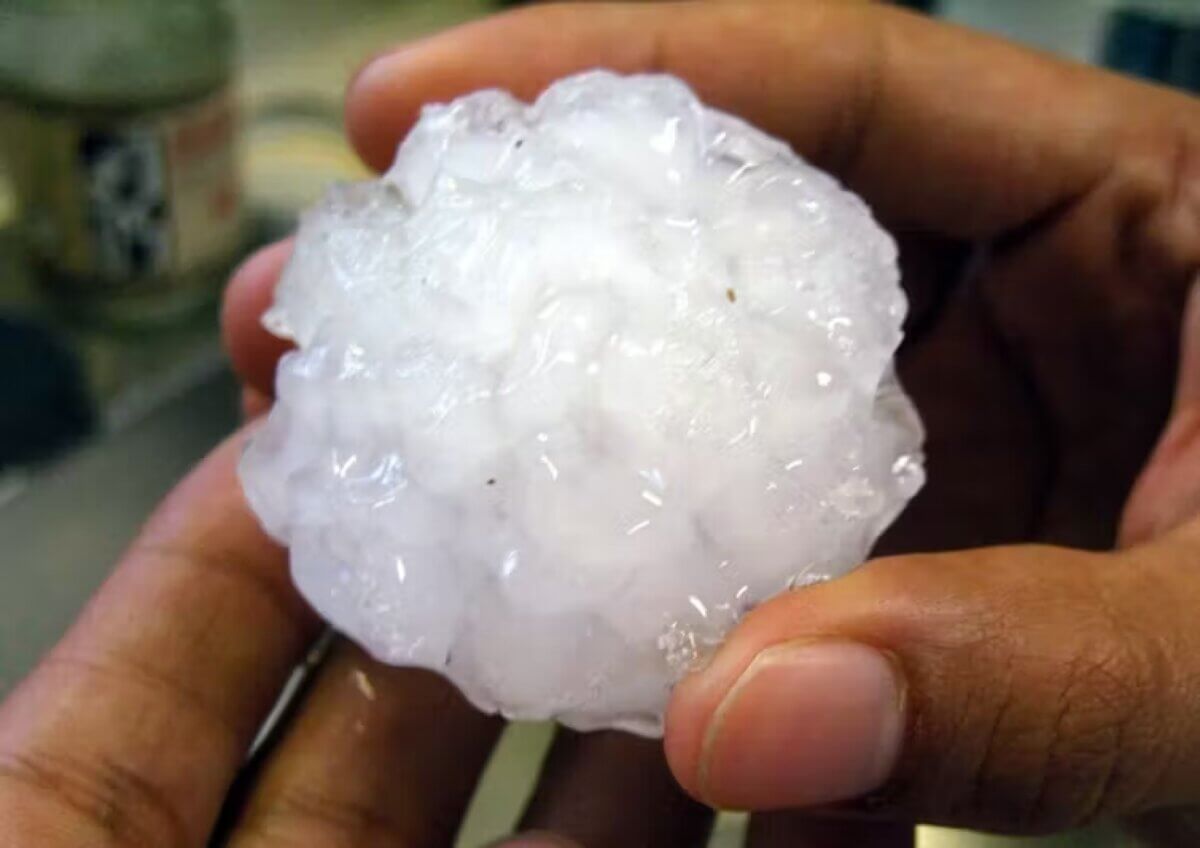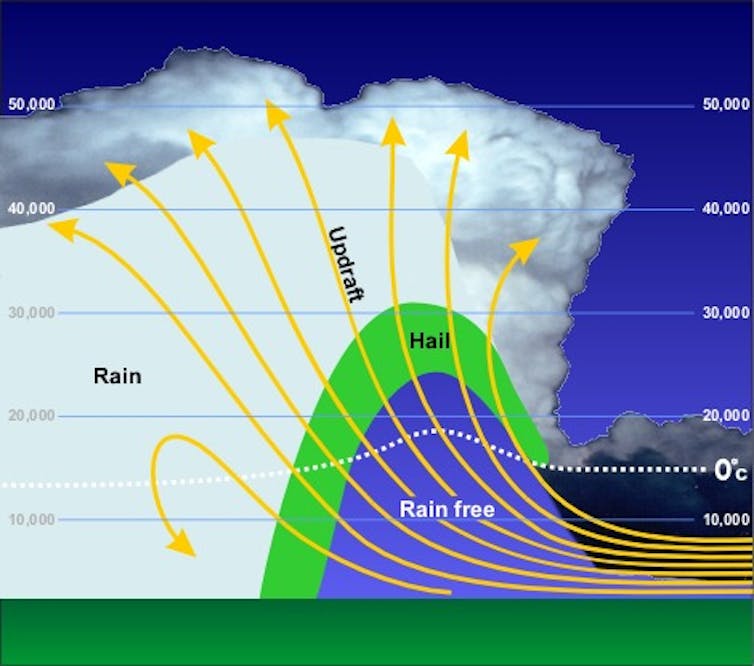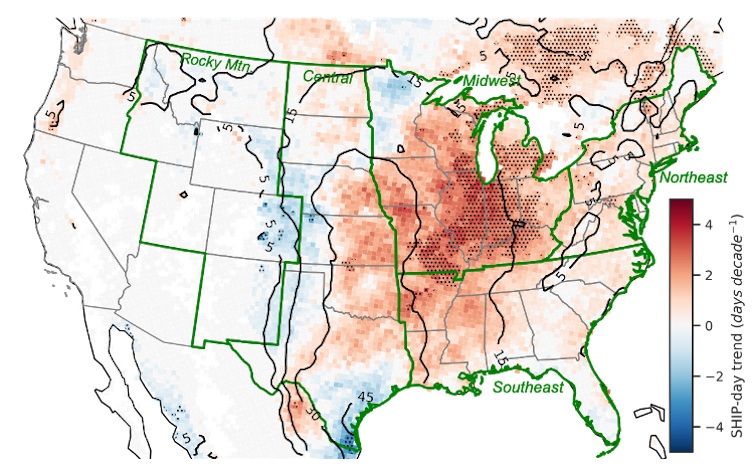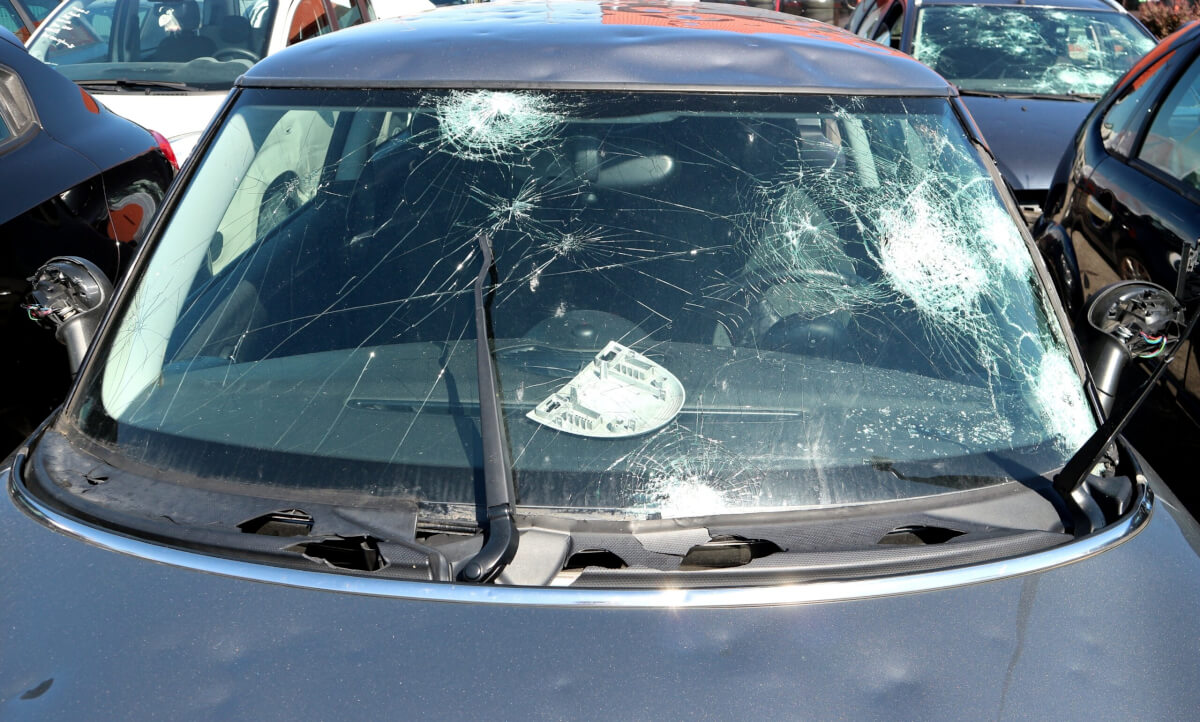
Getting hit by solid ice the size of a baseball would hurt. (Credit: Joe Mindluge/Flickr, CC BY-NC-SA)
Hail the size of grapefruit shattered car windows in Johnson City, Texas, in May 2024. In June, a storm chaser found a hailstone almost as big as a pineapple. Even larger hailstones have been documented in South Dakota, Kansas, and Nebraska. Hail has damaged airplanes and even crashed through the roofs of houses.
How do hailstones get so large, and are hailstorms getting worse?
As an atmospheric scientist, I study and teach about extreme weather and its risks. Here’s how hail forms, how hailstorms may be changing, and some tips for staying safe.
How does hail get so big?
Hail begins as tiny crystals of ice that are swept into a thunderstorm’s updraft. As these ice embryos collide with supercooled water – liquid water that has a temperature below freezing – the water freezes around each embryo, causing the embryo to grow.

Supercooled water freezes at different rates, depending on the temperature of the hailstone surface, leaving layers of clear or cloudy ice as the hailstone moves around inside a thunderstorm. If you cut open a large hailstone, you can see those layers, similar to tree rings.
The path a hailstone takes through a thunderstorm cloud and the time it spends collecting supercooled water dictates how large it can grow.
Rotating, long-lived, severe thunderstorms called supercells tend to produce the largest hail. In supercells, hailstones can be suspended for 10-15 minutes or more in strong thunderstorm updrafts, where there is ample supercooled water, before falling out of the storm due to their weight or moving out of the updraft.

Hail is most common during spring and summer when a few key ingredients are present: warm, humid air near the surface, an unstable air mass in the middle troposphere, winds strongly changing with height, and thunderstorms triggered by a weather system.
Larger hail, more damage
Hailstorms can be destructive, particularly for farms, where barrages of even small hail can beat down crops and damage fruit.
As hailstones get larger, their energy and force when they strike objects increases dramatically. Baseball-sized hail falling from the sky has as much kinetic energy as a typical major league fastball. As a result, property damage – such as to roofs, siding, windows, and cars – increases as hail gets larger than the size of a quarter.
Insured losses from severe weather, which are dominated by hail damage, have increased substantially over the past few decades. These increases have been driven mostly by growing populations in hail-prone areas, resulting in more property that can be damaged and the increasing costs to repair or replace property damaged by hail.
Is climate change worsening hailstorms?
A lot of people ask whether the rise in hail damage is tied to climate change.
My colleagues and I analyzed four decades of hail environments and found that the atmospheric ingredients to produce very large hail – larger than golf balls – have become more common in parts of the central and eastern U.S. since 1979. Other studies that considered formation factors of hail-producing storms or looked at radar estimates of hail have found limited increases in large hail, predominately over the northern Plains.
There are a couple of primary hypotheses as to why climate change may be making some key ingredients for large hail more common.

First, there has been an increase in warm, humid air as the Earth warms. This supplies more energy to thunderstorms and makes supercooled water more plentiful in thunderstorms for hail to grow.
Second, there have been more unstable air masses, originating over the higher terrain of western North America, that then move eastward. As snowpack disappears earlier in the year, these unstable air masses are more apt to form as the Sun heats up the land faster, similar to turning up a kitchen stove, which then heats up the atmosphere above.
Climate change may also lead to less small hail and more large hail. As the atmosphere warms, the freezing level moves up higher in the atmosphere. Small hail would be able to melt completely before reaching the ground. Larger hail, on the other hand, falls faster and requires more time to melt, so it would be less affected by higher freezing levels.
Additionally, the combination of more favorable ingredients for large hail and changes in the character of hailstorms themselves might lead to an increase in very large hail in the future.
How to stay safe in a hailstorm
Being caught in a severe thunderstorm with large hail falling all around you can be frightening. Here are some safety tips if you ever wind up in such a situation:
- If you’re driving, pull over safely. Stay in the vehicle. If you spot a garage or gas station awning that you can seek shelter under, drive to it.
- If you’re outside, seek a sturdy shelter such as a building. If you’re caught out in the open, protect your head.
- If you’re inside, stay away from windows and remain inside until the hail stops.
Dealing with the aftermath of hail damage can also be stressful, so taking some steps now can avoid headaches later. Know what your homeowners and car insurance policies cover. Be aware of roof replacement scams from people after a hailstorm. Also, think preventively by choosing building materials that can better withstand hail damage in the first place.
Brian Tang is an associate professor of Atmospheric Science at the University at Albany, State University of New York
This article is republished from The Conversation under a Creative Commons license. Read the original article.











